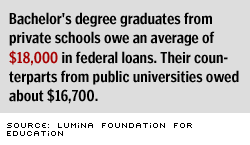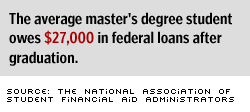NEW YORK (CNN/Money) -
Everyone knows a college education is one of the best investments money can buy. After all, the numbers don't lie.
Bachelor degree recipients earn 80 percent more than high school graduates, The College Board reports.
But covering the costs of higher education gets harder every year. According to the Education Department, some 39 percent of student borrowers graduate with unmanageable levels of debt, meaning their monthly payments absorb more than 8 percent of their take-home pay.

Sure, it's low interest debt and it's tied to an appreciating asset, but let's not kid ourselves. That's a tough check to write when you're fresh out of school and struggling to save for a house, a car and a professional wardrobe. The good news is, there are strategies you can use to lower your bill. And with any luck, you may even be able to pay off your loan ahead of schedule -- freeing up cash for other long-term goals.
The following five steps will get you started.
Consolidate your loans
In today's favorable interest rate environment, anyone looking to eradicate student debt should first consider loan consolidation.
Such a move allows you to roll your existing federal loans into a single low-interest loan -- which can lower your monthly payment by $100 or more. The extra savings can be applied towards the principal on your loan -- helping you to put that debt behind you faster.
"With consolidation, your debts are simplified and condensed and you get lower interest-rates in general," said Sheryl Garrett, a certified financial planner and founder of The Garrett Planning Network. "There is no cost to consolidate and now is the best time to consolidate your federal loans with interest rates currently at a historic low."
Rates on federal Stafford and PLUS loans will remain low at around 4 percent through June 30, 2003 -- so time is on your side.
Build your nest egg
The second step to knocking out your student debt is to get creative with long-term savings tools. Roth IRAs are a good example.
Roth contributions are not tax deductible, as they are for traditional IRAs, but earnings in your account grow tax-free. The best part is such retirement plans allow investors to withdraw their principal (the portion they contributed) tax and penalty-free.
That means you can effectively build your nest egg while you're socking away extra towards your student loans. Here's how:

Let's say you invest $1,000 per year into a Roth. You withdraw that $5,000 principal after 5 years to pay off your student loans. Assuming an 8 percent growth rate, the earnings left behind would total $1,335, an amount that would ultimately grow to $29,000 tax-free by the time you retire.
According to Garrett, funds that may fit the bill for your Roth IRA include Janus's Growth and Income fund, or T. Rowe Price's Capital Appreciation and Midcap Value fund. All three are no load funds, meaning you won't pay to get in or out of the fund.
Garrett said you should also take advantage of their automatic investment plans to keep your savings strategy on track. Both fund families require a low monthly minimum (anywhere from $50 to $100) but they also generally allow you to cancel or skip a month's payment with three days notice if you are in some unexpected bind and cannot spare the cash.
She also notes, however, that you should put the Roth savings strategy on hold if you work for a company that offers a matching benefit in their 401(k). After all, the benefit of pre-tax contributions, compounded earnings and free money from the boss far outweigh the benefits of prepaying your low-interest student loan.
Anything extra you have after funding your 401(k) retirement account and securing the company match can be applied to a Roth for student loan repayment. It's important to know that you can contribute to a Roth and a 401(k) in the same year.
Work those tax breaks
The third step to wiping out student debt is to take advantage of every tax deduction available.
Students are now able to write off a portion of the interest they pay on their loans. Currently, $2,500 is the most you can write off against your taxable income, which translates to a tax savings of about $500 per year. To qualify for the full deduction, you must earn less than $50,000 (or have a household income of less than $130,000 if you're married.)
Again, apply those savings towards your loan. And be sure to let your lender know you want any extra money you send in applied towards the principal -- otherwise the bank may simply apply it towards interest, which won't help you a bit.
Stay humble
The fourth step may sound obvious but it's often taken for granted. When you're fresh out of college you are frugal by force -- you haven't had the luxury of extra cash on hand and have had to do without during the years you spent on campus.
A word of advice: once you land that first job, don't change a thing. Live simply and keep your expenses to a minimum, if only for a few more years, so you can apply extra savings towards your loan. You could save a bundle and put a serious dent in that debt at the same time.
If, for example, you borrowed $80,000 and paid that money back over 10 years at 7 percent interest, your monthly payments would amount to $928.87 per month. And you'd cough up $31,464.08 in interest. By boosting your monthly payment just $250, you would pay off your loan 2 years and 9 months early and save $9,322.61 in interest fees.
(The other option, of course, is to leave your low-interest, tax deductible loan alone and invest that $250 in stocks and mutual funds -- a more risky proposition, but one that historically has enjoyed a 12 percent annual rate of return.)
One way to scare up extra cash without putting a hole in your wallet is to send any financial gifts, annual raises or large bonuses you receive straight to your lender.
Now, most financial planners stress that if you have extra money lying about, you should knock out higher interest, non-deductible debt first. They're right. Top on the list, of course, is credit cards. But if you haven't abused the plastic, and you've got your other monthly bills under control, by all means -- get a jump on your student loans.
Be a good borrower
The fifth and final step towards knocking out your student debt is to simply pay on time. Several lenders offer special discounts for a consistent record of on-time payment or for allowing them to automatically debit your bank account for the payments.
Under the Stafford loan program, for example, if you make your first 24 scheduled monthly payments on time and you have borrowed more than $8,334, you may earn a credit equivalent to the 3 percent origination fee you paid to secure the loan. And most private lenders will give you a full two-percentage point interest rate reduction for the remaining term of your loan if you make the first 48 scheduled monthly payments on time.
There is one last reward you can take advantage of by authorizing an automatic monthly deduction from your checking or savings account. This can give you a 1/4 of a percentage point interest rate reduction for public and private lenders.
So, how much can these credits and interest rate reductions really save you? On a 10-year loan for $17,000 at 8.25 percent, the total interest you'd pay without the discounts is $8,021. By authorizing automatic withdrawals and paying on time regularly, you'd reduce the interest you paid to $6,265 -- saving you $1,756.

|

